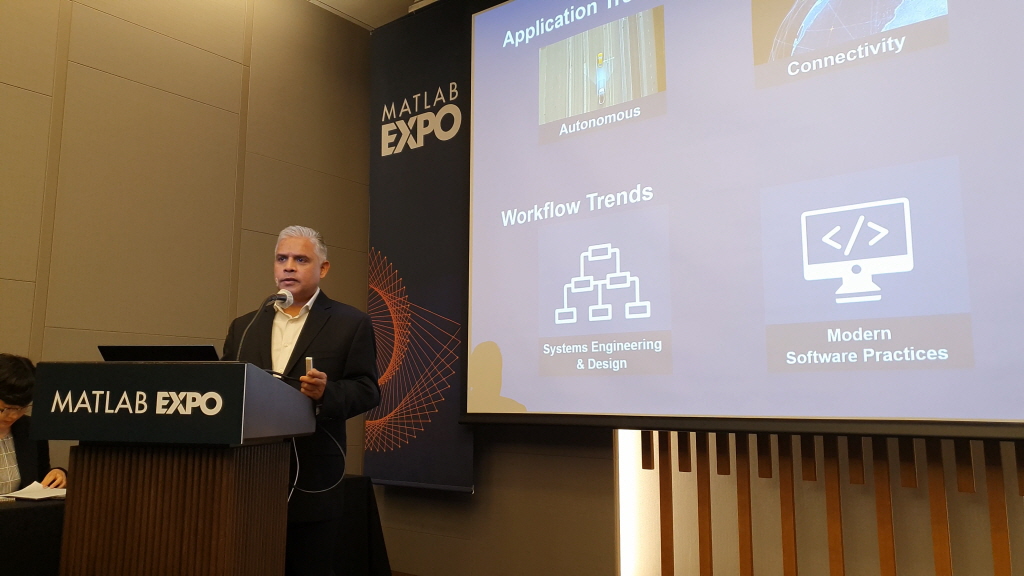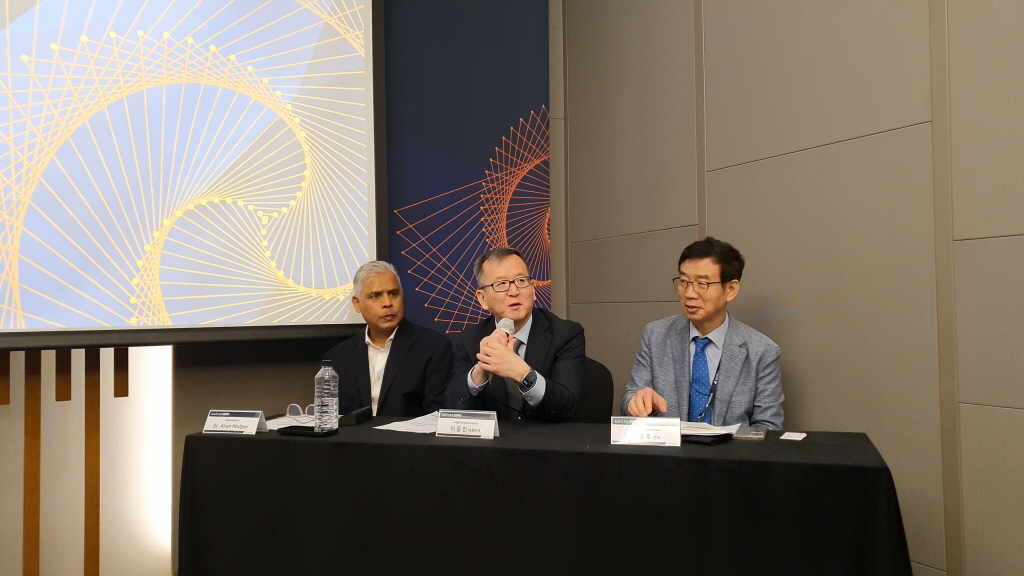“자율주행·커넥티비티·전동화, 모델 기반 개발로 문화 바뀐다”
기사입력 2024.06.11 16:31

▲매스웍스(MathWorks) 아룬 멀퍼(Arun Mulpur) 인더스트리 디렉터가 발표하고 있다.
산업 복잡·다양·개발 지식 차이 극복 자동화로 해결해야
AI 이용 데이터 훈련, 시뮬링크로 모델화해 개발 가속화
AI 이용 데이터 훈련, 시뮬링크로 모델화해 개발 가속화
“자율주행, 커넥티비티, 전동화 등 점점 복잡해지고, 다양한 엔지니어들이 투입되며, 통합 설계가 어려워지고 있는 개발 환경을 극복하기 위해 문서가 아니라 모델을 사용하고, 모델과 데이터를 통합하고, 모델 데이터 시뮬레이션 데이터를 활용해 디자인 활동을 의사 전달하고, 조율하도록 팀 문화를 바꿔야 한다”
매스웍스(MathWorks) 아룬 멀퍼(Arun Mulpur) 인더스트리 디렉터는 11일 그랜드인터컨티넨탈 서울 파르나스에서 진행된 ‘매트랩 엑스포 2024 코리아 기자간담회’에서 디지털 엔지니어링을 위해 모델 기반 설계로 전환해야 한다고 주장했다.
아룬 멀퍼 디렉터는 모델 기반 개발(MBD)이 디지털 엔지니어링의 핵심이라며, 최근 자율주행, 커넥티비티, 전동화에서 가장 빨리 적용되고 있다며, 이 세 분야에서 일하는 방식이 변화하고 있는데, 첫 번째는 엔지니어링 시스템이 복잡해지면서 시스템 엔지니어링이 성장하고 있고, 두 번째는 엔지니어링 회사들이 점차 소프트웨어에 중점을 두고 있고, 시스템 개발 프로세스에 걸쳐서 AI를 많이 사용하고 있다고 밝혔다.
이에 7가지 워크 플로 경향을 살려보면 모든 것을 자동화하려는 경향과 복잡한 시스템설계에서 서비스 중심의 아키텍처 소화를 위해 복잡한 시스템을 작고 독립적인 시스템 컴포넌트로 나누고 이것을 컴포저에서 모델링해 시뮬링크에서 디테일을 채워 전체 시스템을 완성하는 방식으로 변하고 있다고 언급했다.
또한 매스웍스 소프트웨어를 사용한 자동으로 생성된 코드를 사용하고, 결함을 방지하고, 표준적인 소프트웨어 워크플로어를 적용하고, 이를 클라우드에서 시뮬레이션과 디자인 할 수 있어야 한다.
마지막으로 일곱 번째는 인공지능을 어떻게 활용할 수 있는가로 예를 들면 알고리듬을 이용해 양자화된 데이터를 훈련하고, 훈련된 데이터를 매트랩으로 임포트하고, 임포트한 신경망을 시뮬링크 모델로 변환하는 것처럼 인공지능의 활용이 중요하다고 강조했다.
이어 이런 모델 기반 개발은 △자율주행 △센서개발 △컴퓨터 비전 △도로 네트워크 디자인 △UAV △자율주행 잠수정 △로봇 △6G △전기차 △전기모터 △배터리 설계 등 다양한 곳에 적용되고 있다고 밝혔다.
아룬 멀퍼는 “모델 기반 개발은 산업이 점점 복잡해지면서 기계 기술자, 전자 기술자, 소프트웨어 기술자 등 다양한 엔지니어가 투입되는데, 이들 용어 및 사용 도구가 모두 다르고 지식도 모두 다르므로 통합 설계가 점점 어려워지고 있다”며 “모델 기반 개발은 상위 레벨에서 모델을 가지고 가상의 플랫폼으로 시스템을 검증하는 것으로 시뮬링크에서 모든 것을 통합적으로 할 수 있다. 120종류의 도구가 있는데 피지컬 모델링, 커뮤니케이션, 신호처리 등을 한 번에 할 수 있다. 이에 모델 기반 개발은 확산할 것이고, 매스웍스는 그런 부분에서 준비하고 있다”고 밝혔다.

▲(왼쪽부터)매스웍스(MathWorks) 아룬 멀퍼(Arun Mulpur) 인더스트리 디렉터, 이종민 매스웍스코리아 대표이사, 김영우 전무가 질의응답을 하고 있다.
많이 본 뉴스
[열린보도원칙] 당 매체는 독자와 취재원 등 뉴스이용자의 권리 보장을 위해 반론이나 정정보도, 추후보도를 요청할 수 있는 창구를 열어두고 있음을 알려드립니다.
고충처리인 장은성 070-4699-5321 , news@e4ds.com



.jpg)







